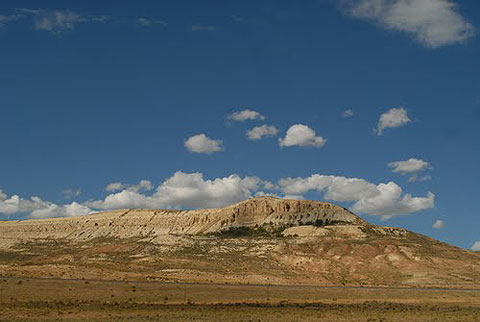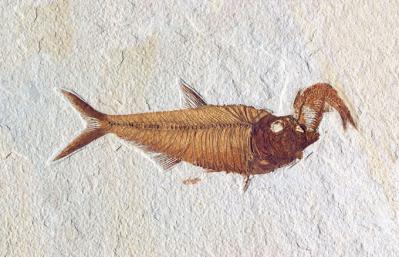- Home
- Encyclopedia
- Fossil Butte National Monument
Fossil Butte National Monument
Fossil Butte National Monument, near Kemmerer, Wyo., was created Oct. 23, 1972, to preserve "outstanding paleontological sites and related geological phenomena," in the words of the congressional act.

The legislation protects 8,200 acres of a 50-million-year-old lakebed, Fossil Lake. During the Eocene Epoch when the lake was formed, southwestern Wyoming and surrounding areas of Utah and Colorado held large lakes in which the sedimentary Green River Formation was deposited, thus preserving some of the best examples of intact fossils ever found.
The climate at the time was subtropical, similar to that of the southeastern United States today. The formation of the Rocky Mountains was warping the landscape into highlands and basins, and an annual rainfall of more than 30 inches was enough to create Fossil Lake and other lakes like it.
Many types of life thrived within the upper waters of the lake. Plankton supported large shoals of herring. Big predatory fish, including gars and dogfish, hunted smaller fish species while catfish and freshwater rays fed on crustaceans. The lower waters, however, contained a poisonous concentration of hydrogen sulfide that prevented scavenging fish from occupying the lake floor.
From time to time, dozens of fish died simultaneously. These mass mortalities may have been due to contamination of the upper water by hydrogen sulfide released by earthquakes or by seasonal turnover of the lake waters; extremes of temperature or salinity; or stagnation caused by drought. Lying on the lake bottom, the fish were undisturbed as lime-rich mud slowly buried them. Green River Formation fish fossils, flattened by the weight of sediment into two-dimensional imprints, frequently show every tooth, rib and fin. Equally well preserved, but less common, are freshwater rays, water and shore birds, frogs, bats, turtles, crocodiles and plants.
Although early explorers of the West such as John C. Frémont and geologist Ferdinand V. Hayden were aware of the fossil beds, significant study of the Green River Formation fossils did not begin until the late 1860s when the Union Pacific Railroad made a cut through the formation near the town of Green River, Wyo.

From fossils passed on to him by railroad employees, paleontologist Edward Drinker Cope described several new species. In 1897, an amateur collector named Robert Craig began quarrying fossils: he was soon joined by other commercial and private collectors. Specimens from the Green River Formation began to be displayed in museums all over the world.
Over the next decades, public interest in these fossils grew. After excavation and preparation work of up to several hundred hours on each piece with a fine-pointed needle, specimens were purchased by museums, private collectors or consumers for use as wall decorations and tiling. In 1993, it was discovered that collectors had used bulldozers to illegally excavate beds on public land near Farson, Wyo., leaving a scene of destruction that one Bureau of Land Management geologist compared to "an Air Force bombing range."
In reaction to such exploitation, Congress set aside the property as a national monument to preserve some Green River Formation outcrops for public viewing and enjoyment. Quarries within the monument are now worked on a limited basis by staff experts. Nearby, the largest remaining commercial quarry in the state, dating from 1943, is run on state land under a state lease by Carl and Shirley Ulrich.
Resources
Primary Sources
- Kohlman, Matt. "Fossil Poachers Steal Potentially Valuable Relics from Public Lands." Los Angeles Times, 9 May, 1993.Accessed December 8, 2011 at http://articles.latimes.com/1993-05-09/local/me-33128_1_public-lands
- U. S. Statutes at Large 86 (1972): 1069. An Act to Establish the Fossil Butte National Monument in the State of Wyoming, and for Other Purposes.
Secondary Sources
- Grande, Lance. Paleontology of the Green River Formation, with a Review of the Fish Fauna. Cheyenne, Wyo.: The Geological Survey of Wyoming, 1980, 3-15; 182-185; 273-275.
- National Park Service, U. S. Department of the Interior. "Fossil Butte—Things To Do,” accessed 10/26/11 at http://www.nps.gov/fobu/planyourvisit/things2do.htm
- Nudds, John and Paul Selden. Fossil Ecosystems of North America: A Guide to the Sites and Their Extraordinary Biotas. Chicago: The University of Chicago Press, 2008, 186-204.
Illustrations
- The photo of a Diplomystus dentatus fossil with Knightia in its mouth is by the National Park service, from an extensive online gallery of photos of fossils from the Green River Formation. Used with thanks. The smaller fish, Knightia, here about 6.5 inches long, is the most abundant vertebrate fossil in the world and the state fossil of Wyoming.
- The photo of Fossil Butte is by John Drew; see more at www.johndrew.com. Used with permission and thanks.
